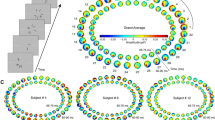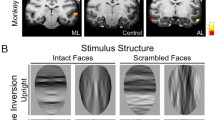Abstract
The scalp-recorded “vertex-positive peak” (VPP) evoked by images of faces in humans has previously been shown to be delayed when an originally upright stimulus is inverted or rotated by 90° (Jeffreys 1989a). This paper describes a study of the effects on this scalp potential of smaller face orientation changes (15° increments). The results showed that, under normal viewing conditions of clearly defined facial images, the VPP latency, which was minimal for face orientations within 15° of the vertical (0°), increased almost linearly for incremental rotations from 15 up to 90°, but was relatively unchanged or decreased slightly for further rotations from 90 up to 180°. Similar results were observed for clockwise and anticlockwise rotations, and for different facial representations. These stimulus orientation changes did not change the latency of simultaneously recorded, pattern-specific potentials recorded from occipital scalp locations; nor did they greatly affect the VPP amplitude. By contrast, rotations of “Mooney figure” stimuli away from the vertical produced concurrent reductions in both the perception of a face and the amplitude of the evoked VPP. Experiments in which the orientation of both the stimulus face and the subject's head were varied further showed that minimal latency VPP responses were evoked for parallel stimulus and viewing orientations. The speed of response is thus determined by the orientation of the subtended retinal image.
Similar content being viewed by others
References
Bötzel K, Grüsser O-J (1989) Electric brain potentials evoked by pictures of faces and non-faces: a search for “face-specific” EEG-potentials. Exp Brain Res 77:349–360
Carey S (1992) Becoming a face expert. Philos Trans R Soc Lond [Biol] 335:95–103
Carey S, Diamond R (1977) From piecemeal to configurational representation of faces. Science 195:312–314
Desimone R (1991) Face-selective cells in the temporal cortex of monkeys. J Cogn Neurosci 3:1–8
Gross CG (1992) Representation of visual stimuli in inferior temporal cortex. Philos Trans R Soc Lond [Biol] 335:3–10
Grüsser O-J, Kirchhoff N, Naumann A (1990) Brain mechanisms for recognition of faces, facial expressions, and gestures: neuropsychological and electroencephalographic studies in normals, brain-lesioned patients, and schizophrenics. In: Cohen H, Bodis-Wollner I (eds) Vision and the brain. Raven, New York, pp 165–193
Humphreys GW, Quinlan PT (1987) Normal and pathological processes in visual object constancy. In: Humphreys GW, Riddoch MJ (eds) Visual object processing: a cognitive neuropsychological approach. Erlbaum, Hilisdale, pp 43–105
Jasper H (1958) Report of the committee on methods of clinical examination in electroencephalography. Electroencephalogr Clin Neurophysiol 10:370–375
Jeffreys DA (1977) The physiological significance of pattern visual evoked potentials. In: Desmedt J (eds) Visual evoked potentials in man: new developments. Clarendon, Oxford, pp 134–167
Jeffreys DA (1989a) A face-responsive potential recorded from the human scalp. Exp Brain Res 78:193–202
Jeffreys DA (1989b) Evoked potential studies of contour processing in human visual cortex. In: Kulikowski JJ, Dickinson CM, Murray IJ (eds) Contour and colour. Pergamon, London, pp 529–545
Jeffreys DA, Axford JG (1972) Source locations of pattern-specific components of human visual evoked potentials. I. Component of striate cortical origin. II. Component of extrastriate cortical origin. Exp Brain Res 16:1–40
Jeffreys DA, Tukmachi ESA (1991) Human scalp potentials evoked by face images of different orientation (abstract). J Physiol (Lond) 438:299P
Jeffreys DA, Tukmachi ESA (1992) The vertex-positive scalp potential evoked by faces and by objects. Exp Brain Res 91:340–350
Jeffreys DA, Tukmachi ESA, Rockley G (1992) Evoked potential evidence for human brain mechanisms that respond to single, fixated faces. Exp Brain Res 91:351–362
Joliceur P (1985) The time to name disoriented natural objects. Mem Cogn 13:289–303
Kemp R, McManus C, Piggot T (1990) Sensitivity to the displacement of facial features in negative and inverted images. Perception 19:531–543
Lu ST, Hamalainen MS, Hari R, Ilmoniemi RJ, Lounasmaa OV, Sams M, Vilkman V (1991) Seeing faces activates three separate areas outside the occipital visual cortex in man. Neuroscience 43:287–290
Mooney CM (1956) Closure with negative after-images under flickering light. Can J Psychol 10:191–199
Parkin AJ, Williamson P (1987) Cerebral lateralisation at different stages of facial processing. Cortex 23:99–110
Perrett DI, Smith PAJ, Potter DD, Mistlin AJ, Head AS, Milner AD, Jeeves MA (1984) Neurones responsive to faces in the temporal cortex: studies of functional organization, sensitivity to identity and relation to perception. Hum Neurobiol 3:197–208
Perrett DI, Smith PAJ, Potter DD, Mistlin AJ, Head AS, Milner AD, Jeeves MA (1985) Visual cells in the temporal cortex sensitive to face view and gaze direction. Proc R Soc Lond [Biol] 223:293–317
Perrett DI, Mistlin AJ, Chitty AJ (1987) Visual neurones responsive to faces. Trends Neurosci 10:358–364
Perrett DI, Mistlin AJ, Chitty AJ, Smith PAJ, Potter DD, Broeniman R, Harries M (1988) Specialized face processing and hemispheric asymmetry in man and monkey: evidence from single unit and reaction time studies. Behav Brain Res 29:245–258
Rock I (1973) Orientation and form. Academic, New York
Rock I (1974) The perception of disoriented figures. Sci Am 230:78–85
Rolls ET (1992) Neurophysiological mechanisms underlying face processing within and beyond the temporal cortical visual areas. Philos Trans R Soc Lond [Biol] 335:11–21
Rolls ET, Baylis GC (1986) Size and contrast have only small effects on the responses to faces of neurons in the cortex of the superior temporal sulcus of the monkey. Exp Brain Res 65:38–48
Sergent J (1984) An investigation into component and configurational processes underlying face perception. Br J Psychol 75:221–242
Shepard RN, Metzler J (1971) Mental rotation of three-dimensional objects. Science 171:701–703
Valentine T (1988) Upside-down faces: a review of the effects of inversion upon face recognition. Br J Psychol 81:141–145
Valentine T, Bruce V (1988) Mental rotation of faces. Mem Cogn 16:556–566
Yin RK (1969) Looking at upside-down faces. J Exp Psychol 81:141–145
Young AW, Hellawell D, Hay DC (1987) Configural information in face perception. Perception 16:747–759
Author information
Authors and Affiliations
Rights and permissions
About this article
Cite this article
Jeffreys, D.A. The influence of stimulus orientation on the vertex positive scalp potential evoked by faces. Exp Brain Res 96, 163–172 (1993). https://doi.org/10.1007/BF00230449
Received:
Accepted:
Published:
Issue Date:
DOI: https://doi.org/10.1007/BF00230449




